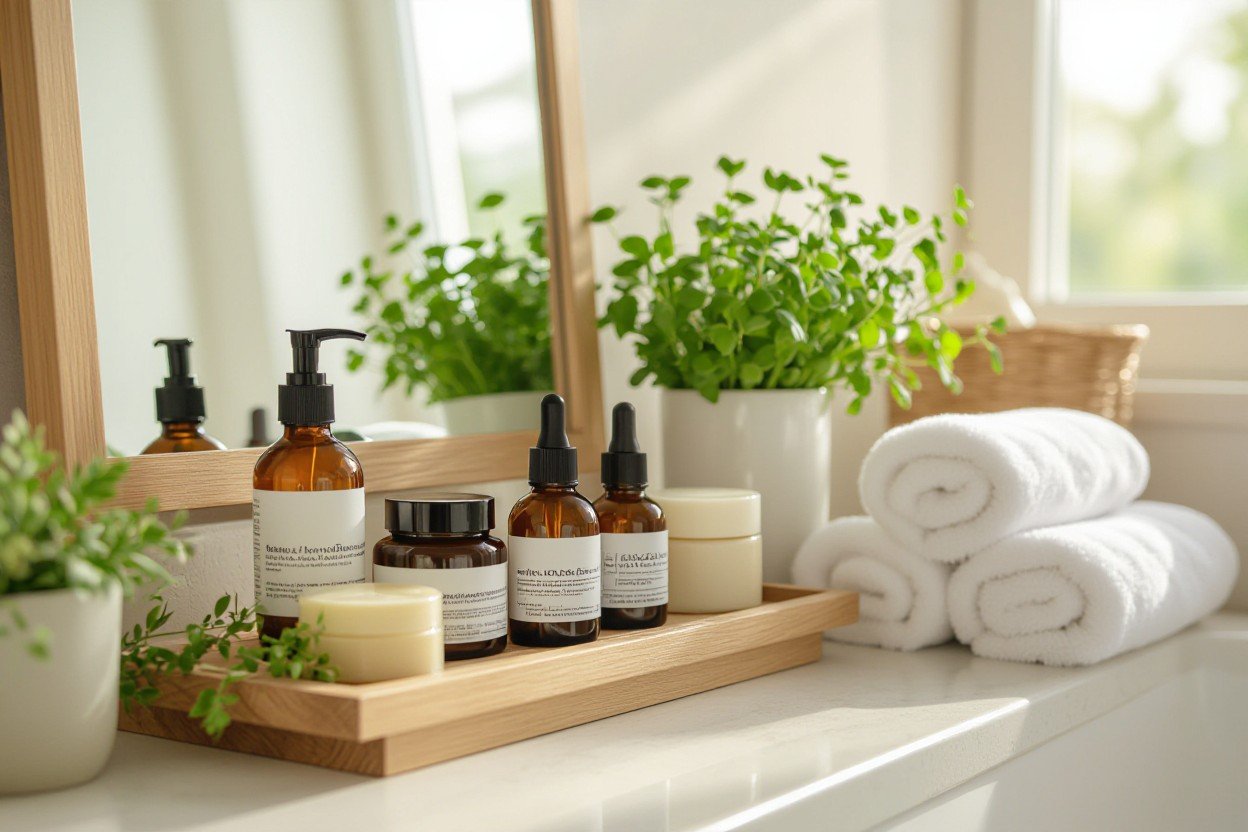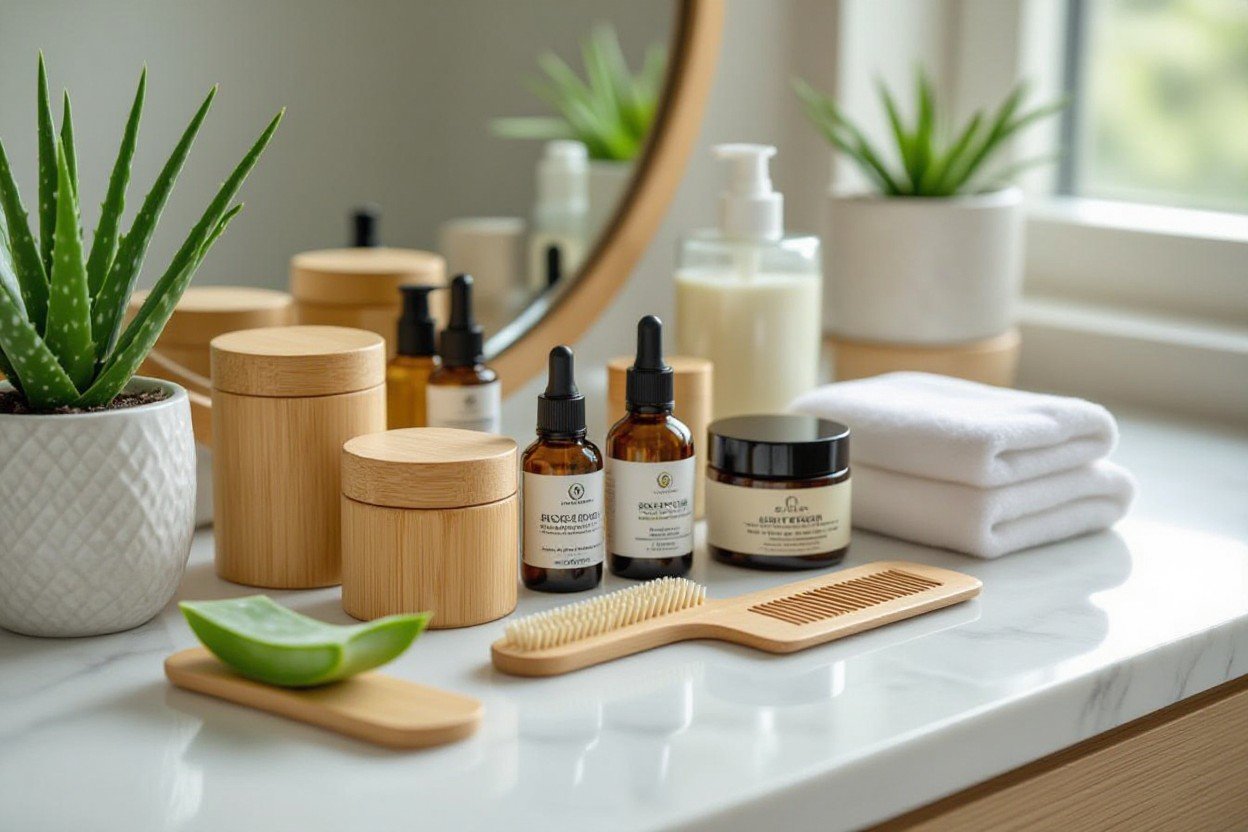Your Cart
Your Cart is currently empty.

Conora guides you through building a simple, effective natural hair and skin routine for your unique needs using castor oil, aloe vera, coconut oil, and shea butter, focusing on gentle techniques and ingredient benefits. You’ll learn step-by-step care, how to avoid harmful chemicals, and how to patch-test to prevent allergic reactions. Embrace daily rituals that boost moisture and confidence; natural ingredients support healthy hair and skin without harsh additives.

Years of routine use of conventional products can leave your scalp dry, hair brittle, and skin sensitized; sulfates strip natural oils and repeated silicone use creates a surface buildup that masks damage. Switching to plant-based formulas like those with castor oil, aloe vera, coconut oil, and shea butter helps restore lipid balance, reduce irritation, and support barrier repair. Expect gradual improvements over 6–12 weeks as you replace aggressive surfactants and preservatives with gentler, nourishing alternatives.
Sulfates (SLS/SLES), parabens, phthalates, and formaldehyde releasers are common offenders that can cause scalp irritation, accelerate moisture loss, and in some studies show endocrine-disrupting potential. You may notice immediate effects like redness, itchiness, or dull hair from silicone buildup that prevents moisture penetration. Choosing products without these ingredients reduces acute irritation and prevents long-term cumulative stress on hair follicles and the skin barrier.
Natural actives deliver targeted benefits: castor oil supports scalp circulation and thickness, aloe vera calms inflammation and adds hydration, coconut oil penetrates the hair shaft for protein retention, and shea butter seals moisture with vitamins A and E. Regular use preserves barrier function, reduces transepidermal water loss, and promotes healthier hair growth cycles over months rather than masking symptoms.
Apply a weekly 1:1 castor+coconut oil mask for 30–60 minutes to boost sheen and reduce breakage; use aloe vera gel as a leave-in or pre-wash scalp treatment to cut flaking within 7–14 days; replace heavy silicone serums with a light shea-based sealant at night to restore overnight moisture. Small, consistent swaps—cleansers without sulfates, conditioners with fatty acids, and preservative-minimal formulations—yield measurable improvements in elasticity, shine, and reduced sensitivity within 6–12 weeks.
Audit your products, simplify to a 3–4 step routine, and introduce substitutes one at a time so you can track effects over 4–8 weeks; start with a sulfate-free cleanser, a hydrating leave-in with aloe vera, and a weekly deep-condition using a mix of castor oil and shea butter for strength and moisture. Patch-test new items, keep a log of changes in texture, shine, and breakage, and prioritize scalp health with gentle massaging to boost circulation.
List every product and read INCI labels, noting the first five ingredients and any sulfates, parabens, or silicones, which often cause buildup or irritation. Track usage frequency, scalp/oil levels, breakage points, and do a simple porosity float test (high porosity hair sinks faster). Convert that audit into three clear goals—moisture, protein, or barrier repair—and plan one product swap per week to isolate results.
Choose formulas that place plant oils and extracts in the top five ingredients; look for castor oil for growth support, aloe vera for hydration and pH balance, coconut oil for penetration, and shea butter as an occlusive. Favor gentle surfactants like decyl glucoside or sodium cocoyl isethionate over harsh sulfates, and prioritize products with transparent preservative systems and clear concentration cues.
Read INCI order to ensure active botanicals aren’t trace amounts—if castor oil appears after multiple silicones, efficacy will be limited. For cleansers, avoid sodium lauryl sulfate and pick formulations with pH 4.5–6.5 to protect skin and scalp; for moisturizers, balance humectants (glycerin, hyaluronic acid) with occlusives (shea, oils). Swap a weekly silicone-laden conditioner for a DIY mask: 1 tbsp castor + 2 tbsp coconut oil warmed and applied 30 minutes before rinse to test improvement in elasticity and shine over a month.

You’ll find Conora Beauty centers formulas around castor oil, aloe vera, coconut oil, and shea butter to repair and protect without harsh additives. Castor oil’s ricinoleic acid (~90%) supports scalp circulation, aloe vera delivers vitamins A, C and E for hydration, coconut oil’s lauric acid (~50%) reduces protein loss in strands, and shea butter supplies fatty acids for barrier repair—combined to replace sulfates, parabens and silicones with effective, plant-based actives.
You can use castor oil to stimulate growth by massaging a warmed 1–2 teaspoon blend with coconut oil into your scalp 1–2 times weekly; aloe vera gel soothes irritation and boosts moisture when applied post-wash; coconut oil reduces protein loss when used as a pre-wash treatment; and shea butter locks in moisture on ends. These ingredients provide measurable benefits while keeping routines simple and free from synthetic foaming agents and dimethicone.
You should know “natural” often lacks legal definition in cosmetics, so look beyond marketing claims: for USDA labeling, “organic” = 95%+ organic ingredients, “made with organic” = 70%+. Certifications like ECOCERT and COSMOS enforce ingredient sourcing and processing standards, while plain “natural” can still contain preservatives or synthetic solvents—check the INCI list for accuracy rather than trusting front-of-pack buzzwords.
You’ll want to scan ingredient lists for red flags such as SLS/SLES, parabens, phthalates, PEGs and hidden synthetics listed under “fragrance.” Seek products that publish full INCI listings and third-party seals; Conora Beauty practices full ingredient transparency so you can verify plant percentages and preservative systems rather than guessing from vague labels.
Schedule a simple weekly plan: deep-condition once weekly with castor oil or aloe vera, cleanse gently 2–3 times per week, and moisturize nightly using shea butter or coconut oil. You should use a patch test for new blends and limit heat to under 180°C; avoid sulfates and fragrances that cause dryness. Track results with photos every two weeks and adjust routines based on your scalp and skin response. After four weeks, reassess frequency and ingredients if you notice persistent irritation or buildup.
The Conora Beauty guide empowers you to build a natural hair and skin routine using gentle ingredients like castor oil, aloe vera, coconut oil, and shea butter, with clear steps for cleansing, conditioning, and moisturizing; by following simple, safe practices you can protect your skin and hair from harsh chemicals and gain confidence through consistent care.
A: Begin by identifying your hair porosity and skin type. For hair: cleanse with a gentle, sulfate-free shampoo as needed (weekly to biweekly), follow with a moisturizing conditioner, and use a deep-conditioning mask once a week made from shea butter and a little coconut oil to seal moisture. Add a scalp massage with castor oil diluted 1:1 with coconut oil for circulation and to support stronger-looking strands; leave 30–60 minutes or overnight if tolerated, then wash out. For skin: use a mild cleanser, apply aloe vera gel as a soothing hydrating layer, and lock in moisture with a light application of shea butter or a thin layer of coconut oil on dry areas; use thinner oils sparingly on facial skin if you’re prone to breakouts. Keep routines consistent—morning: cleanse, hydrate (aloe), protect with SPF; evening: cleanse, treat (targeted oil or aloe), and seal with shea butter for body or a light oil for face.
A: Always perform a patch test: apply a pea-sized amount of the product or mixture behind the ear or on the inner forearm and check for 24–48 hours. For castor oil on the scalp, dilute with coconut oil (1:1) to reduce stickiness and apply sparingly to the roots; frequency 1–2 times weekly. Use aloe vera as a primary hydrating step—pure gel is usually safe for most skin types and helps soothe inflammation. Apply shea butter to body areas with dry skin and use a light touch on the face; coconut oil can be comedogenic for some facial skin, so test it first or reserve it for hair and body. If you experience redness, persistent itching, or swelling, stop use and consult a healthcare professional.
A: Expect gradual change over 4–8 weeks as hair and skin rebalance. Transition by simplifying: replace one product at a time (for example swap your body lotion for a shea butter blend first, then change shampoo to a gentle natural option the following week). Avoid using multiple strong actives at once; give each new product two to three weeks to show its effect. If you see temporary flakiness or small breakouts, this can be an adjustment phase—reduce frequency of new treatments and focus on hydration with aloe vera and gentle cleansing. If irritation persists beyond two weeks or worsens, discontinue the product and seek professional advice.
Leave a Reply